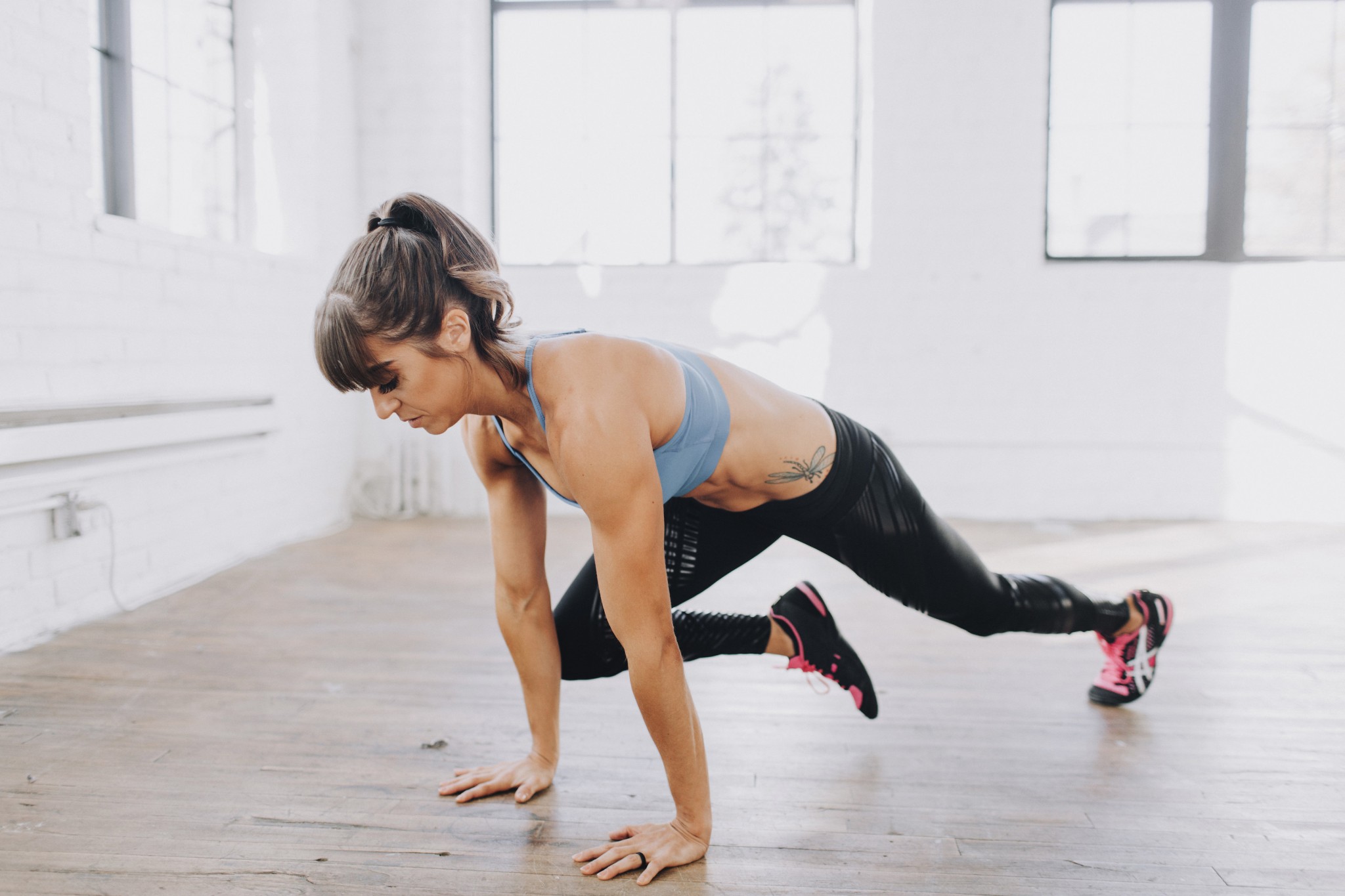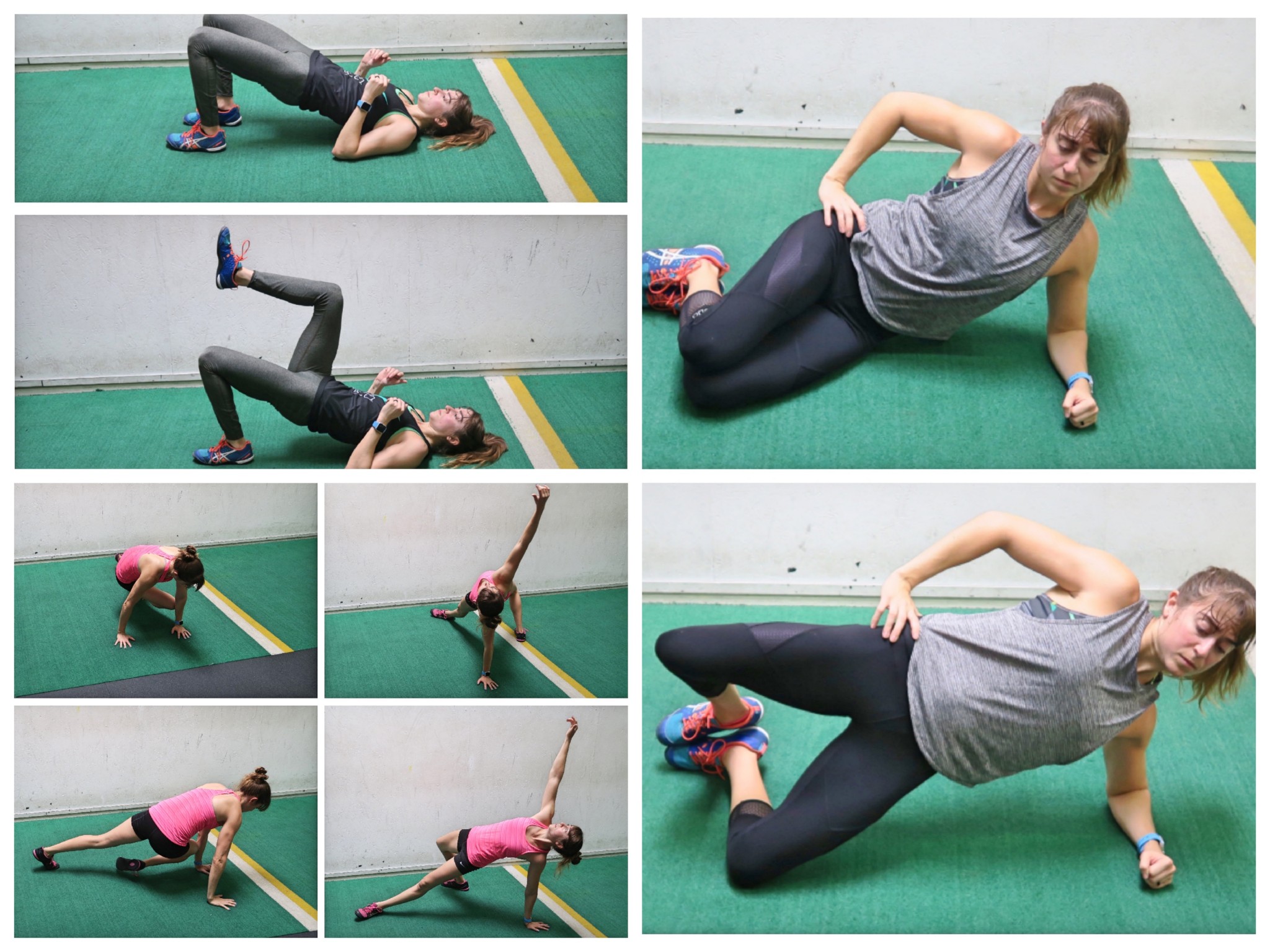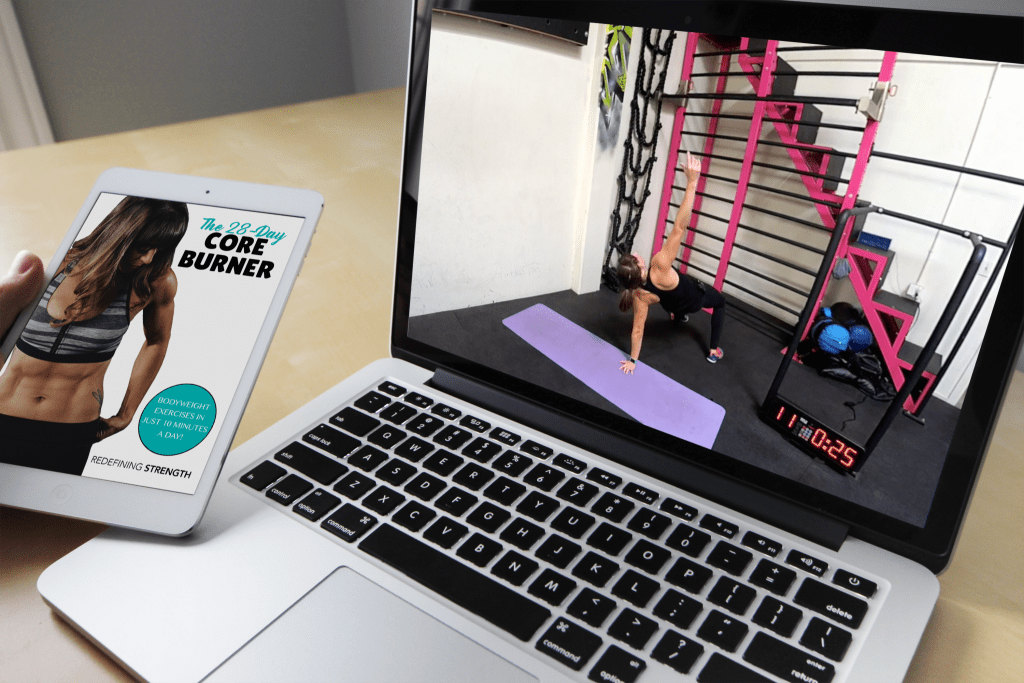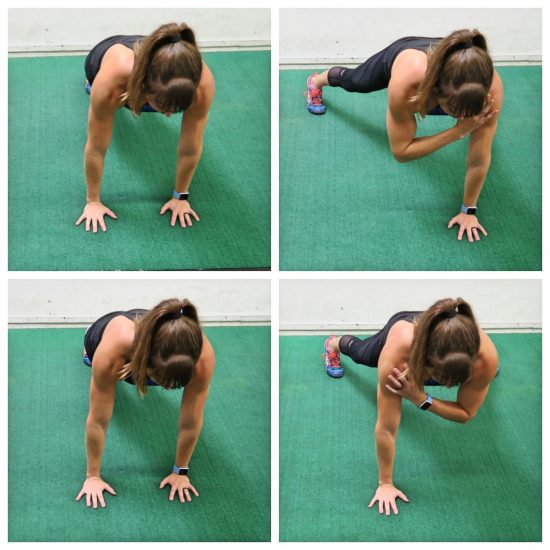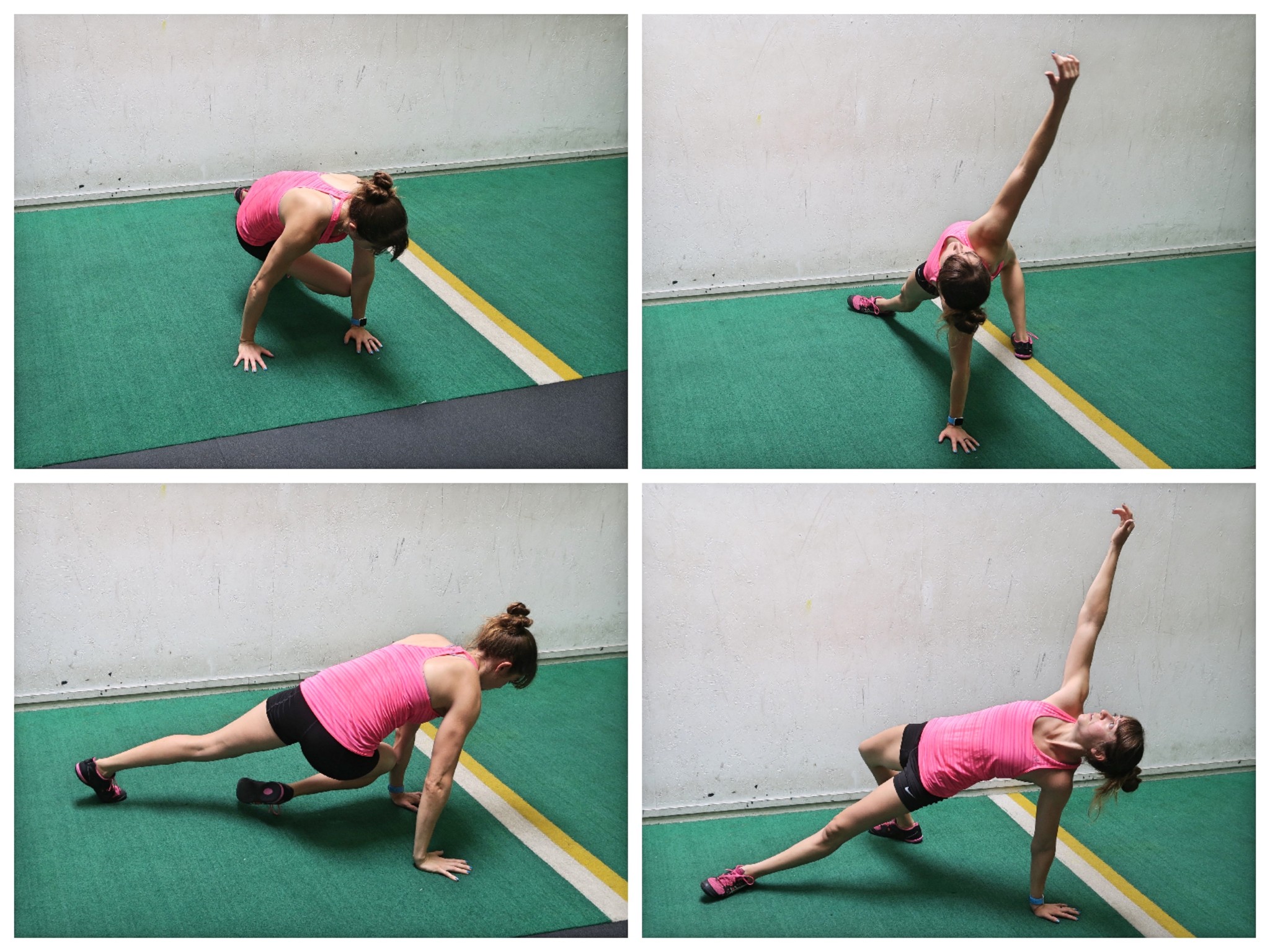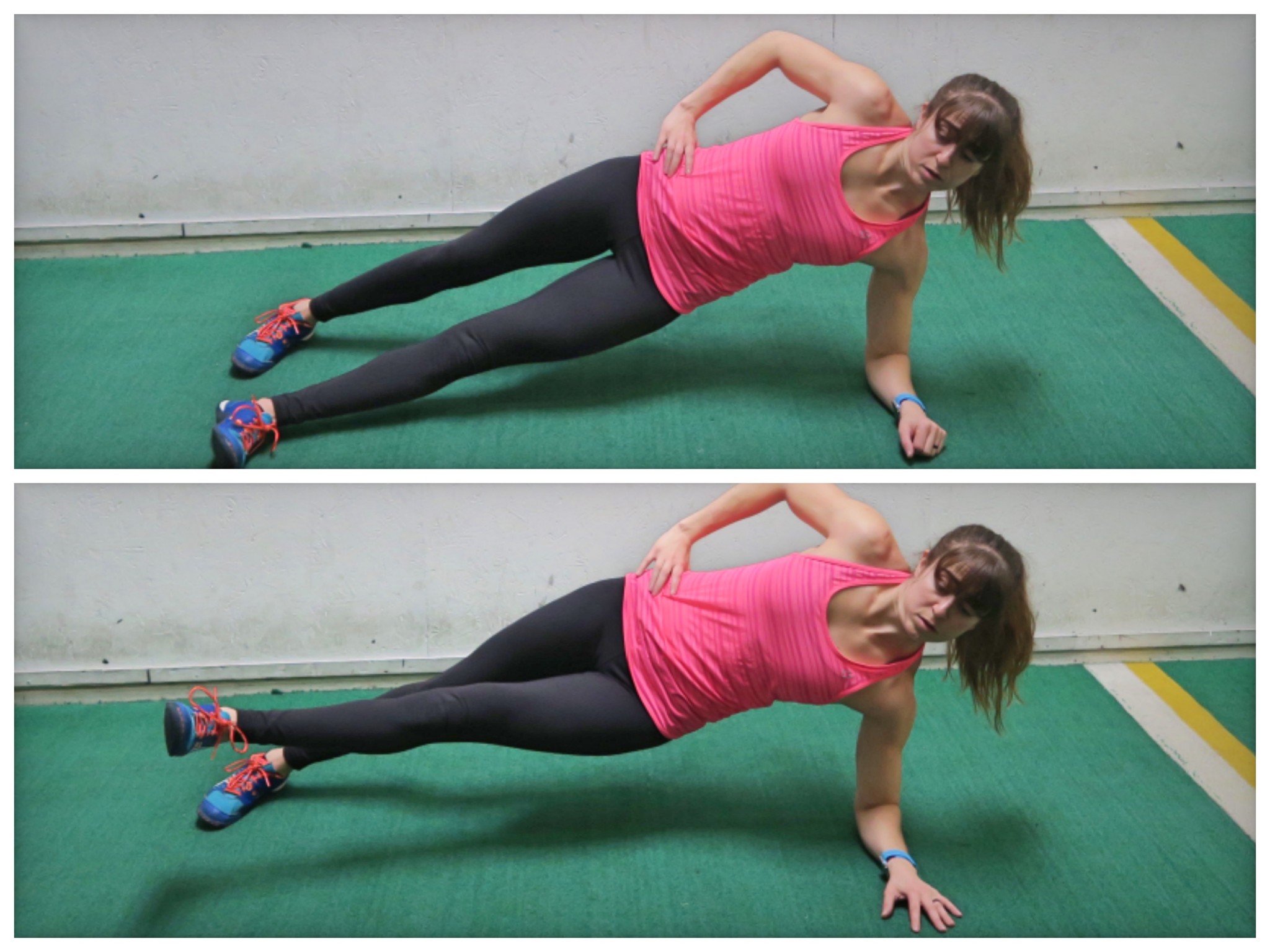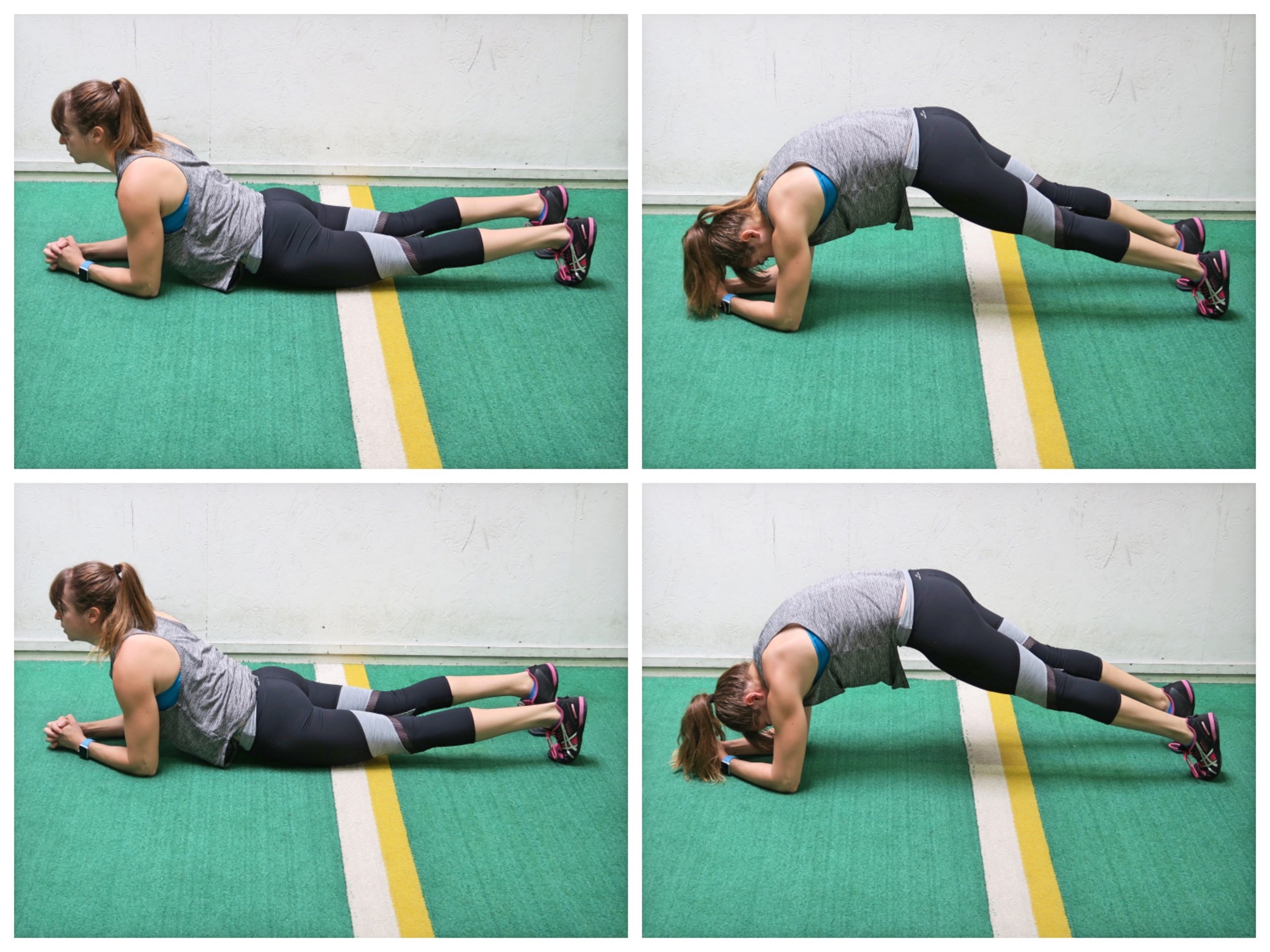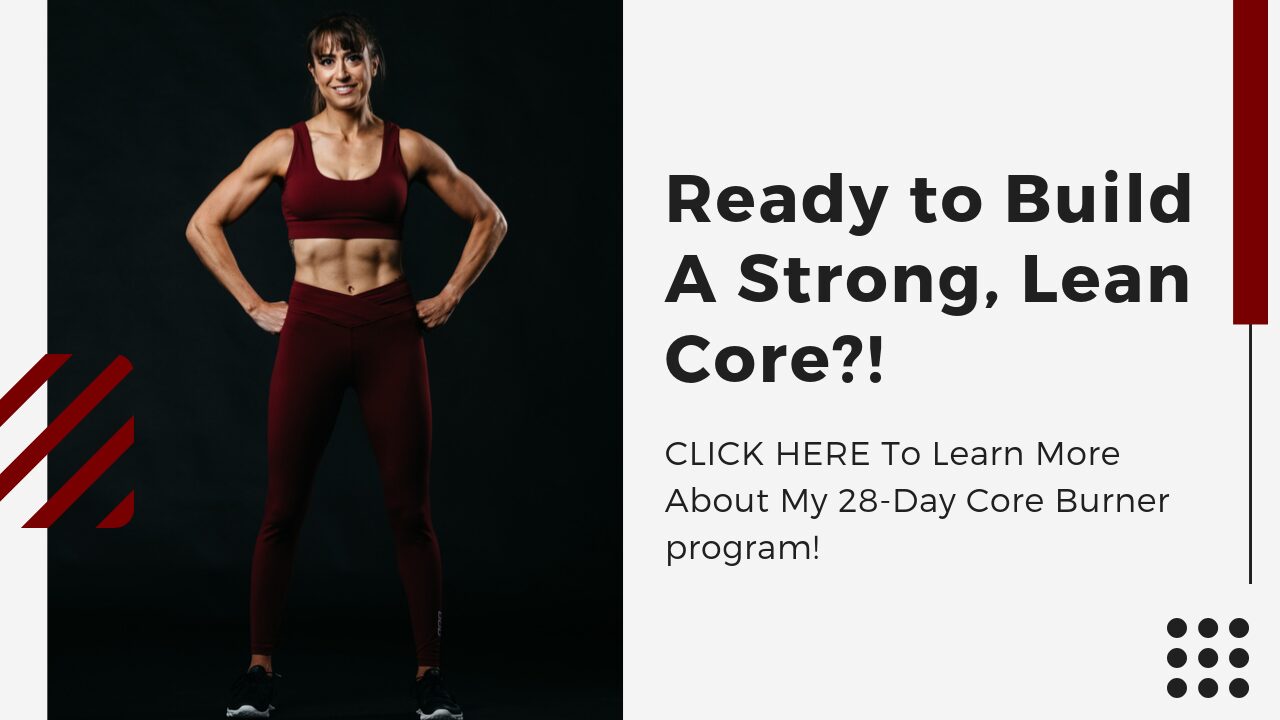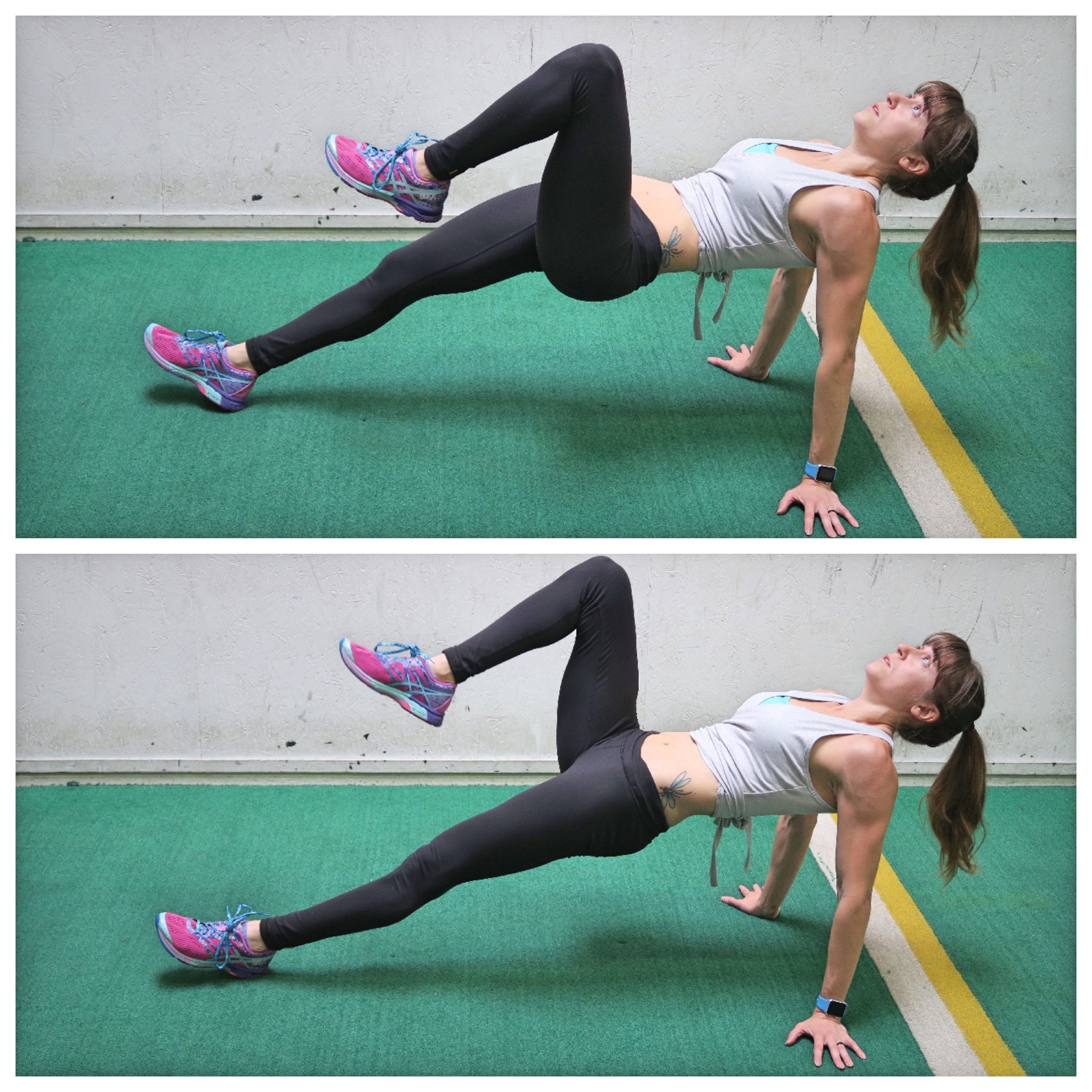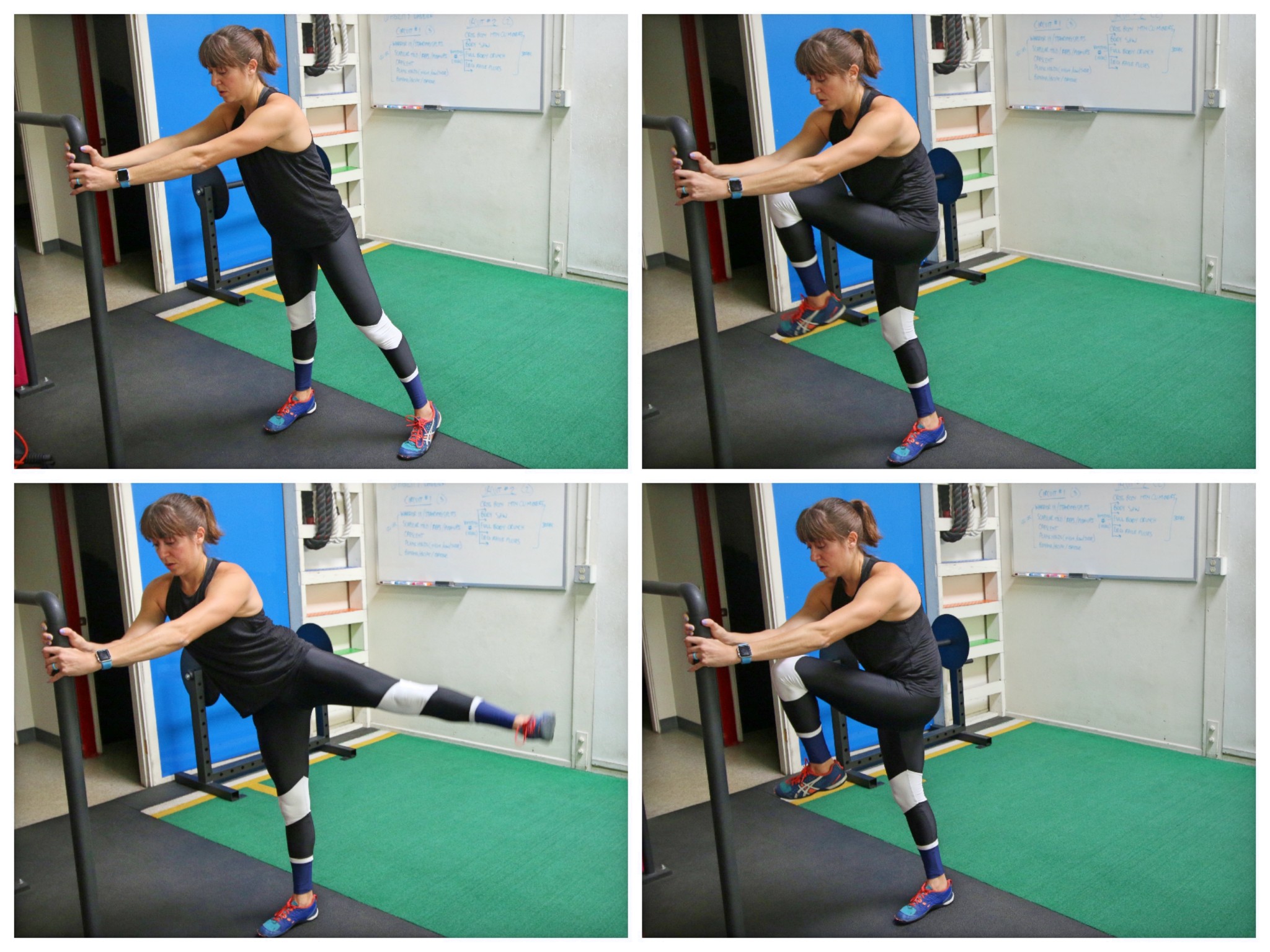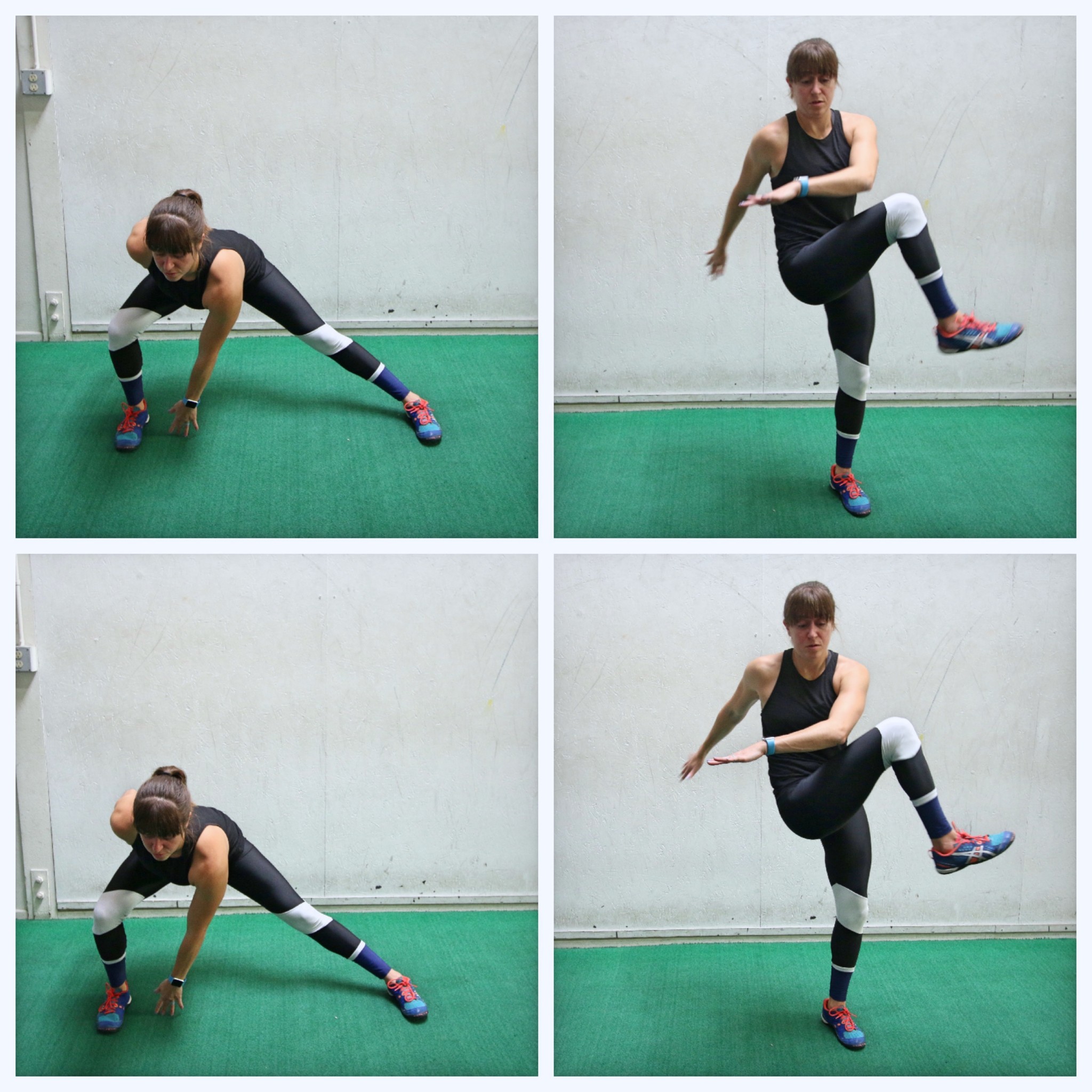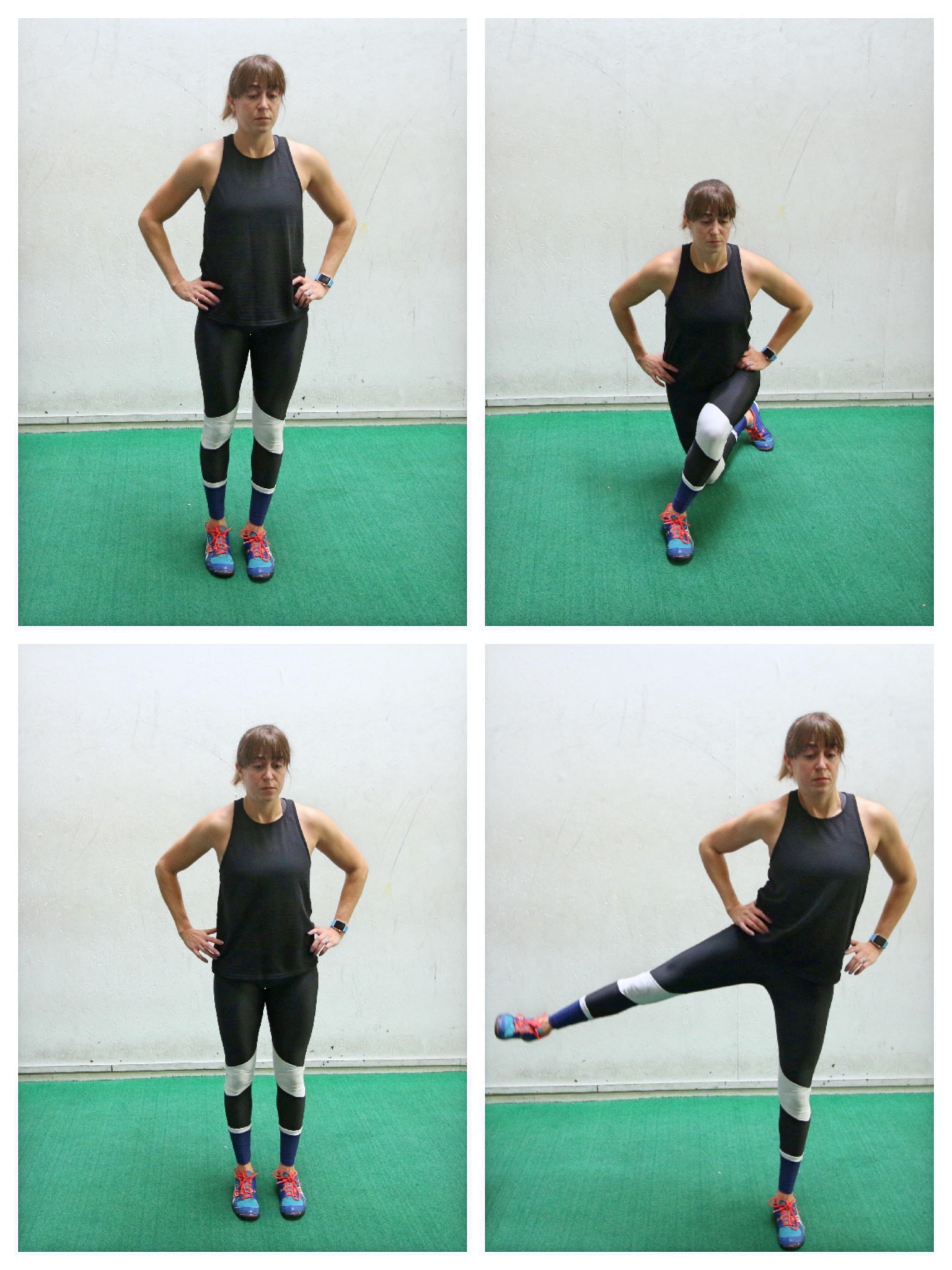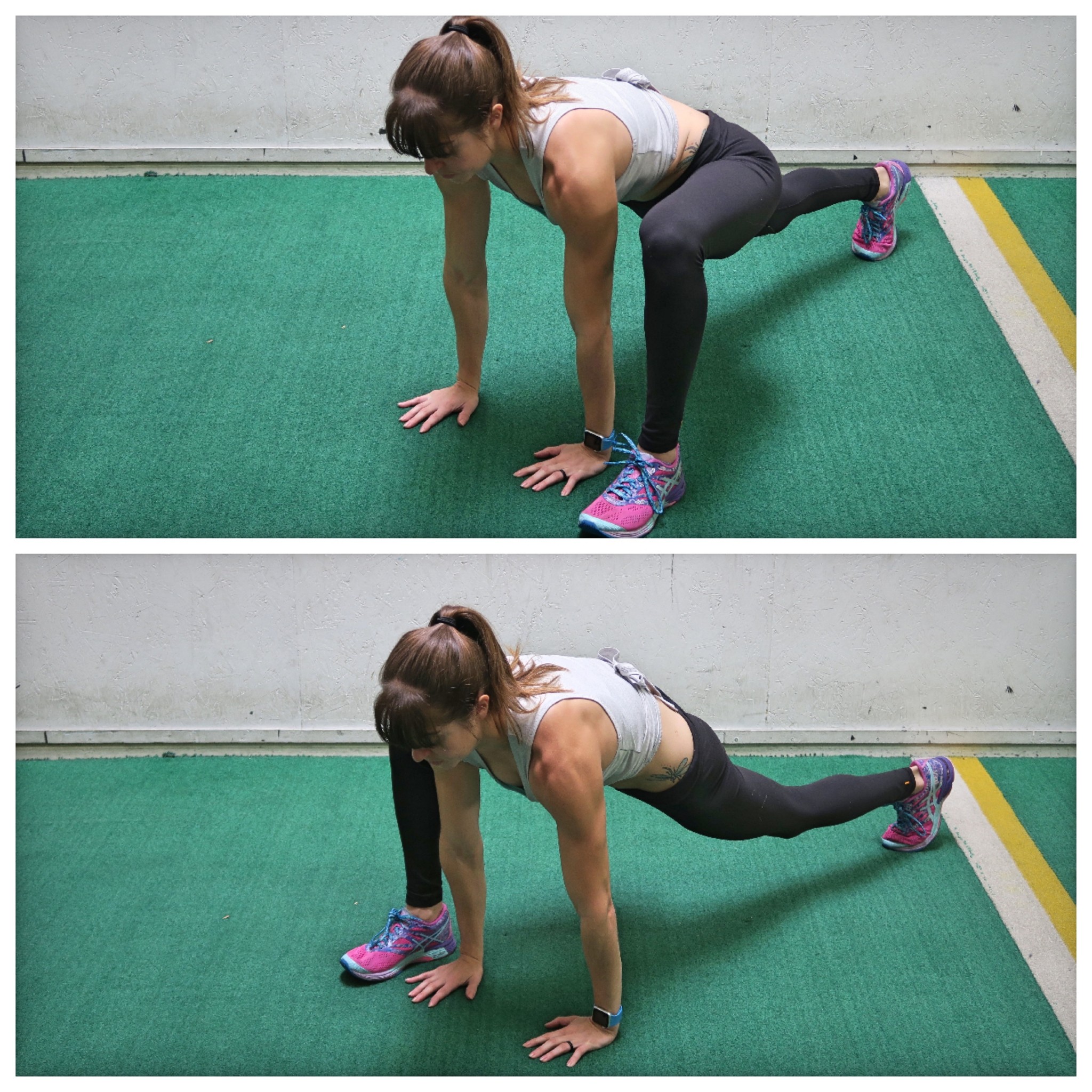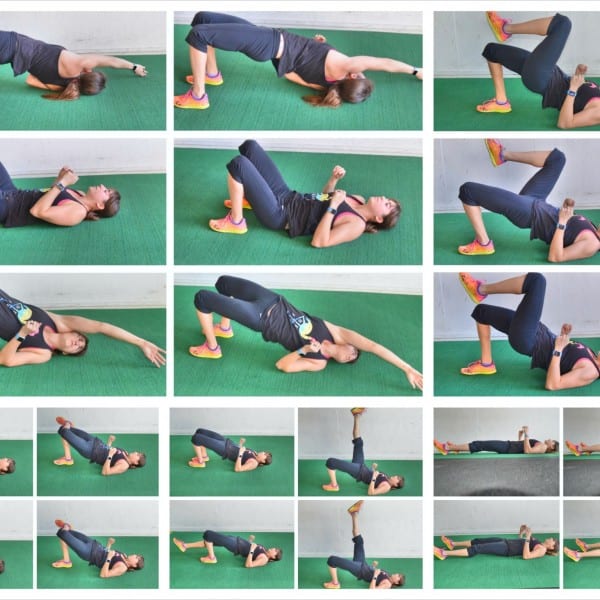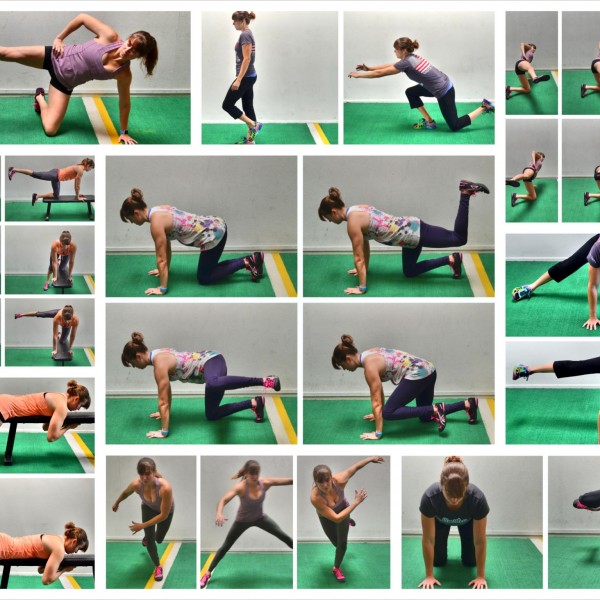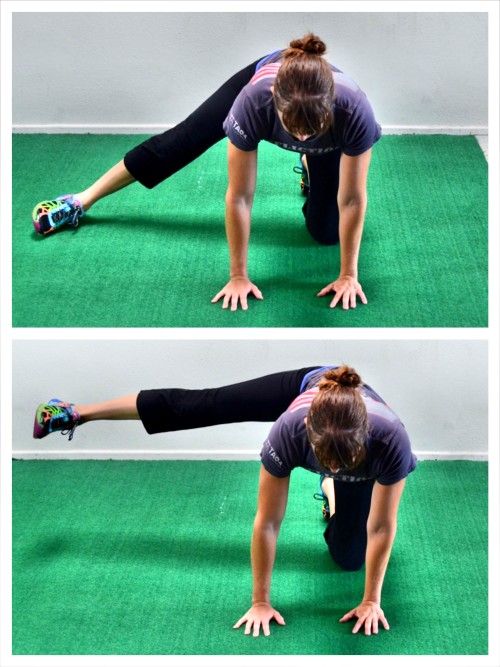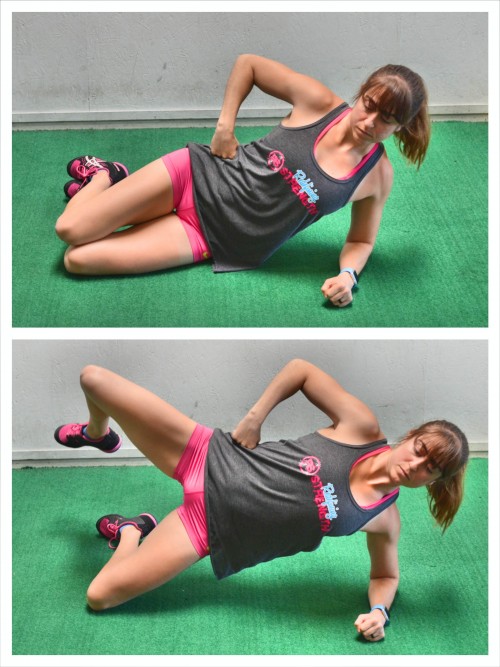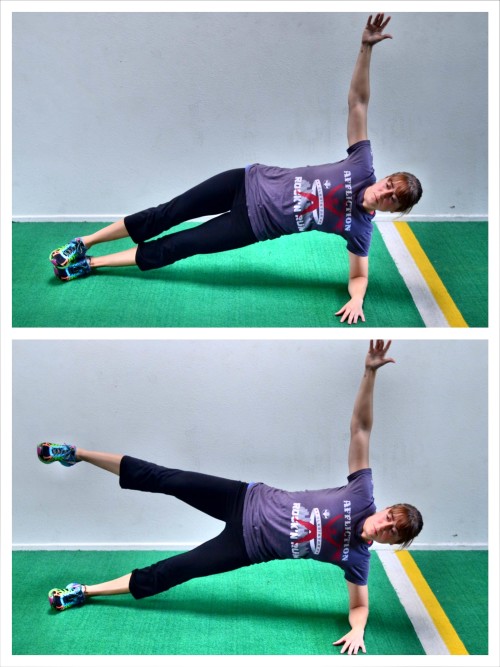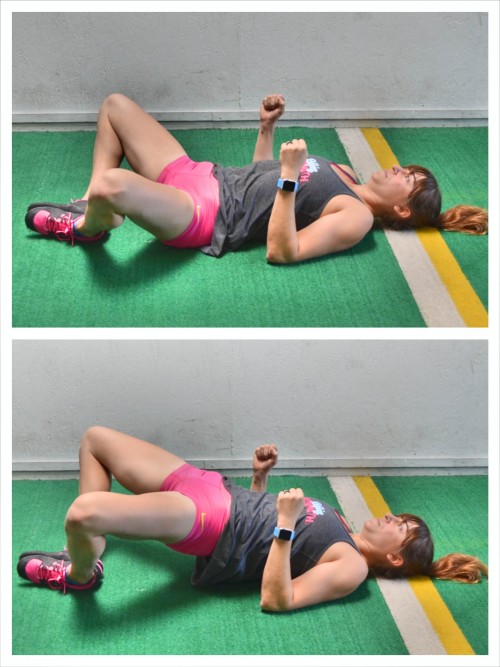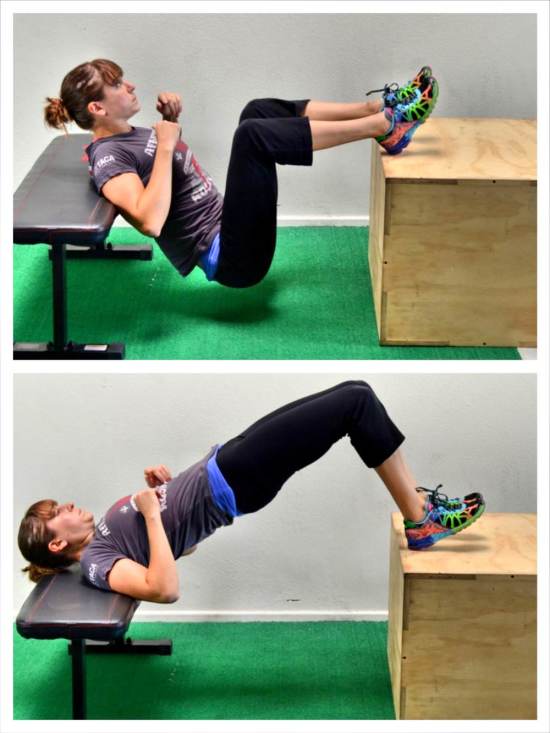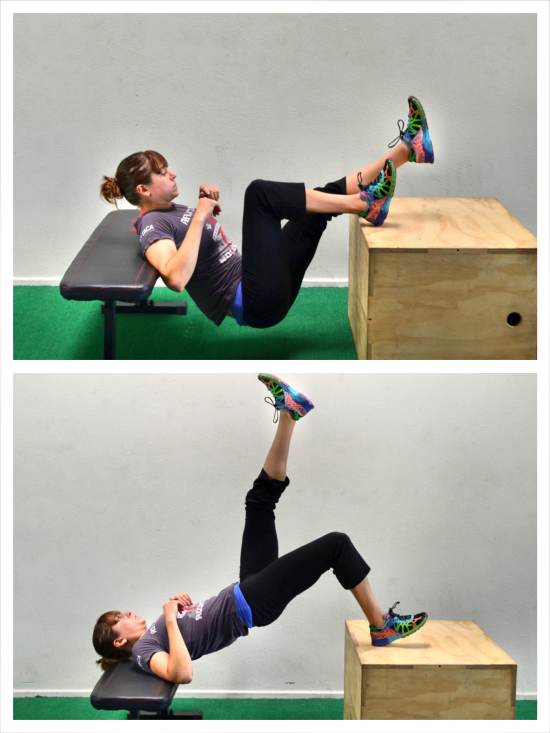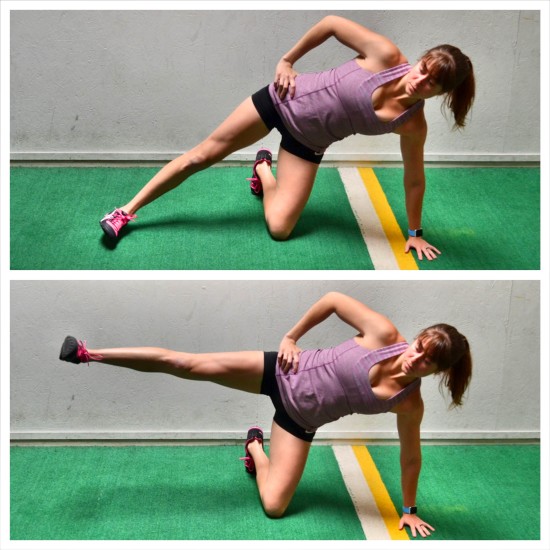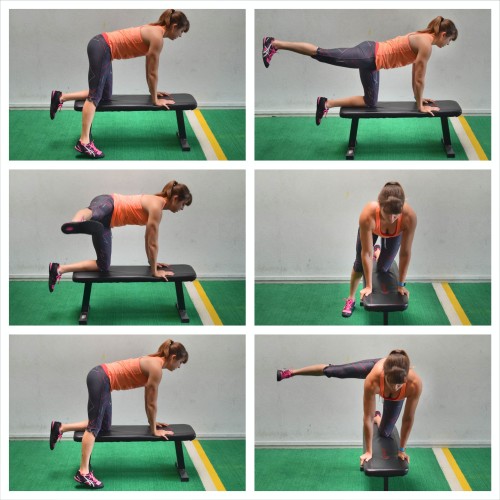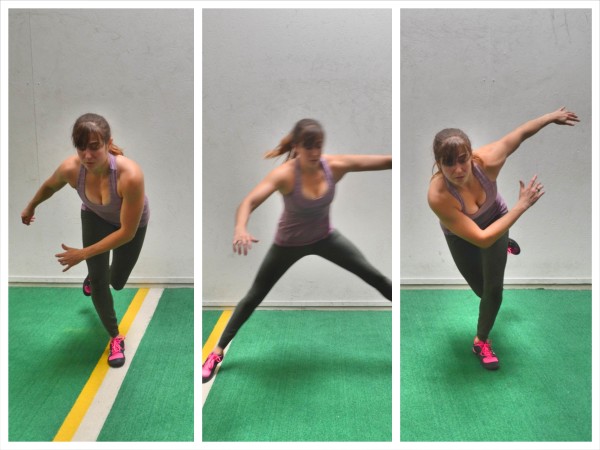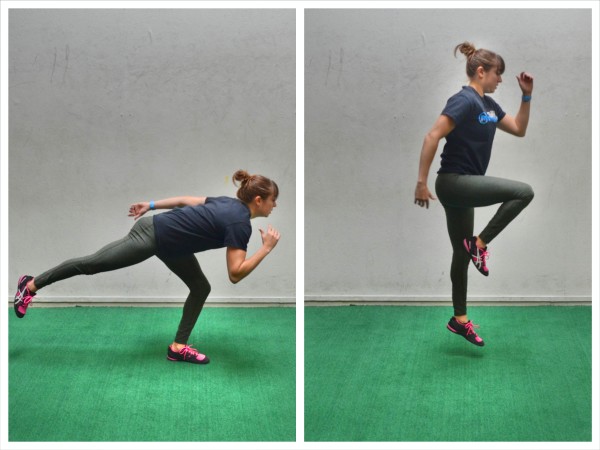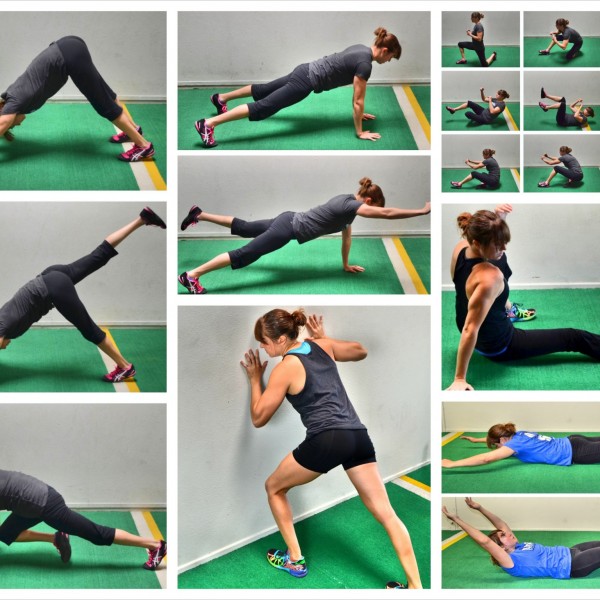
by Cori Lefkowith | Dec 21, 2017 | Blog, Bodyweight, Core, Exercises
Focused core work is important if we want to build a strong, lean core that not only looks amazing but also helps us run faster, lift more and prevent aches, pains and injuries!
We need moves that really activate and work our abs and glutes while strengthening everything between our shoulders and our knees, down our frontsides AND our backsides.
The more muscles we can work at once, and the more planes of motions we can move in, the stronger our core will be and the faster we will achieve results.
That is why I love these 10 Bodyweight Core Moves. They work your core from every angle and even get your blood pumping so you can burn fat as you strengthen your core.

10 Bodyweight Moves To Redefine Your Core
I use these 10 Bodyweight Moves in my 28-Day Core Burner to help clients get faster results. These core intensive exercises work both your anterior and posterior chain. They include rotational and anti-rotational moves and really work your core from every direction.
They work your balance and not only work your abs, but also your oh so important glutes. These moves will give you more bang for your buck in less time!
1. Single Arm Plank Jacks:
This is a great cardio-core move that will also build shoulder stability and work on anti-rotational core strength. You’ll feel this working everything between your shoulders and your knees as you start to sweat!
This is an advanced move though. Beginners may need to start with the Basic Plank Jack or even a Plank Step Jack. It can even be done with your hands up on an incline to modify!

To do Single Arm Plank Jacks, set up in a high plank position with your hands a bit closer together under your shoulders and your feet together. Brace your abs and make sure your body is in a nice straight line.
Then jump your feet out wide, and as you do, lift one hand to touch your opposite shoulder. Resist the urge to really rotate as you lift the hand or let your butt go up in the air. Try to keep your hips down and your core as square to the ground as possible.
Jump your feet back together and place the hand back down. When you quickly jump your feet out again, this time lift the other hand to touch your opposite shoulder. Jump quickly back in and lower the hand back down. Keep repeating the jack with your feet, alternating which hand you lift to tap your shoulder.
Beginners can do a basic Plank Jack without the shoulder tap. For the Basic Plank Jack, click here.
2. Mountain Climber Turkish Bridge:
This rotational exercise will work…well…basically everything! It works your abs, the muscles around your rib cage, your glutes, you shoulders and your quads. Heck even your back!

To do the Mountain Climber Turkish Bridge, set up in a high plank position with your feet about shoulder-width apart and your hands under your shoulders. Then drive one knee in and across your body to the opposite elbow, like a cross-body mountain climber. Move to straighten that leg back out and, as you do, kick it back over your body to rotate open into the Turkish Bridge.
So if you tucked your right knee in, you will then rotate your right leg back over your body to the left as you lift your right hand up off the ground so you can fully rotate open.
You’ll lift your hand up toward the ceiling as you place the foot of the leg you kicked over flat on the ground. That knee will be bent as your other leg stays straight. Keep your hand on the ground under your shoulder and bridge your hips up by squeezing your glute. Make sure the foot of the leg you kicked over is flat on the ground to help you engage and load that glute. Pause here briefly and really focus on bridging up as your hand stays under your shoulder.
Then bring the leg back over and in for the cross body mountain climber. Feel around your rib cage work as you rotate as well as your abs in the mountain climber and glutes in the bridge portion. Move at a controlled pace so you can feel everything working.
Beginners may need to do the move with their hands up on an incline or even break it down and do a set of Cross Body Mountain Climbers followed by a set of the Turkish Bridge.
3. Warrior III Abs:
Balance moves, such as the Warrior III Abs, not only strengthen your feet and legs, but also help you build core stability. On top of that, the Warrior III Abs will also work your glutes and improve your hip mobility!

To do Warrior III Abs, set up in the Warrior III position, balanced on one leg with your raised leg driving back toward the wall behind you and your hips square to the ground. Reach your hands out overhead, reaching toward the wall in front of you.
Staying hinged over, crunch the knee of your raised leg in toward your chest as you pull your elbows in toward your knee. Really use your abs to crunch your elbows toward your knee. Do not stand up though as you crunch.
Then extend back out. Stay balanced on your standing leg and try to stay hinged over as you tuck and extend. Do not touch your toe down unless needed to stay balanced. Beginners may tap it down between reps to rebalance or even reach their hands out in front to lightly touch the wall.
4. Side Plank Adductor Raise:
Your inner thighs, or adductors, are important core muscles that contribute to hip and knee stability. One great way to work them to build stability, as you strengthen your glutes and obliques, is with the Side Plank Adductor Raise.

To do the Side Plank Adductor Raise, set up in a side plank from your forearm and feet. You will want you elbow to be under your shoulder and your feet unstacked with your bottom foot in front and even slightly angled forward. Lift up into the side plank position with your top hand on your hip and your chest not rotated toward the ground. Drive through the sides of your feet and flex your feet to engage even your lower leg.
Holding this position, lift and lower that bottom leg, raising it up a few inches then putting it back down at a controlled pace. Stay up in the side plank the entire time and don’t let your hips sag. Do not place your top hand down to assisted.
If you need to modify, bend that top leg and place the foot flat on the ground behind you OR even regress fully to a side lying adductor lift. Both are shown below.

5. Dolphin Planks:
This plank almost makes you look like you’re doing everything wrong. You are going to sag your hips AND round your back at the top. But talk about a way to kill your abs!
The plange plank position, or rounded position at the top where you draw your belly button in, is going to get your abs shaking. And then when you dip your hips, you are just lowering down and stopping just before your abs disengage. AKA you are making your abs work to brace and stabilize as you move up and down in the plank position and getting your core intrinsic stabilizers to really work!

To do Dolphin Planks, set up in a plank from your forearms and toes (advanced) or knees (beginner). Make sure your shoulders are stacked over your elbows. Brace your core and engage your back as you hold your body in a nice straight line from your head to your heels or knees.
Then sag your hips toward the ground without completing relaxing onto the ground before rounding your back up toward the ceiling. You want to sag your hips only as low as you can without your low back taking over. You should feel your abs still engaging.
When you round up at the top, you aren’t simply sticking your butt up in the air. You want to round your entire back and perform the pelvic tilt. It is almost like you are doing the “cat” in the cat/cow stretch. Do not push backward too much as you do it. Keep your shoulders stacked over your elbows.
Then lower back down and sag your hips before rounding back up. Pause in each position to really feel your core working. Beginners can do this from their knees, off an incline or even modify and do the Vomiting Cat on their hands and knees.

6. Posterior Plank Mountain Climbers:
Often when we think about working our core, we think about working our abs and the front of our body. But our posterior chain is also important to work because one of the most important muscle groups of our core is the GLUTES!
Posterior Plank Mountain Climbers not only work your abs but also your posterior chain, including your glutes, back and hamstrings. The move also works on hip extension and will open up your chest. It is a great move to reverse all of the forward flexion we do sitting hunched over our computers and phones!

To do the Posterior Plank Mountain Climbers, sit on the ground with your legs out straight in front of you and your hands down behind your butt on the ground.
Then, driving up through your heels and your hands, press your hips up toward the ceiling and press your chest out. As you bridge up, squeeze your butt and lift your hips up as high as you can while keeping your legs straight and your chest pressed out. Do not shrug your shoulders at the top as you press your chest out.
Hold at the top with your body in a nice straight line. Do not hyperextend your back. Then slowly tuck one knee in toward your chest. Tuck it in as far as you can.
Then straighten the leg back out. Place the foot back down then tuck your other knee in. Feel your glutes and hamstrings working to hold you up as your abs work to tuck your knee in. Beginners can start with a tabletop variation as they tuck instead of the full Posterior Plank.
7. Cross Body Knee with Lateral Raise:
This standing core move is great if you can’t get down on the ground. Plus it is a unilateral move that will work your abs and glutes, especially your glute medius. Unilateral moves are great to help correct imbalances and make sure that each side of your body pulls its own weight!

To do Cross Body Knee with Lateral Raise, you’ll want a chair or wall right in front of you that you can lean forward and place your hands or forearms on.
Leaning forward bring one knee up and across under your body toward your opposite elbow, drawing your abs in as you tuck. Then kick the leg up and out to the side as high as you can but do not rotate as you kick laterally. Feel your glute working to lift. Do not really lean away but instead keep yourself balanced by leaning onto something.
After kicking out, lower your leg down and tuck your knee back in toward your opposite elbow, feeling your abs and not just your leg work to draw the knee in and across your body. Move at a controlled pace. Tucking and then performing a lateral raise or lateral kick.
8. Side Lunge with Knee:
Working your legs and abs at the same times is the perfect way to build a strong core AND burn more calories in less time. Anytime you can get more muscles working at once, especially BIG muscle groups, you up your calorie burn as you build strength.
The Side Lunge with Knee will get your blood pumping as you strengthen your legs, glutes and abs, especially your obliques.

To do the Side Lunge with Knee, start standing tall then lunge out to the side, sitting your butt back as you hinge forward slightly and load your glute. Push your butt back and sink down, bending your outside knee as your other leg stays straight. You can reach to the ground or keep your hands at your chest. It can even be helpful to reach the opposite arm toward the heel you lunged out with to help you sit back.
Then quickly drive back to standing and, without touching your foot down if possible, drive that knee up and in across your body. You can rotate your upper body toward that knee almost as if pulling someone’s head down and across your body into your knee. Touch the toe down if needed then repeat the lunge back out followed by the quick knee drive.
Feel your legs working with the lunge and your abs working with the knee drive and rotation.
Beginners may not sink as low in the lunge or step out as far. They may also touch their toe down to balance between the lunge and knee drive.
9. Curtsy Lunge to Leg Lift:
Moving in every plane of motion is key to building a strong core that prevents injury. And this Curtsy Lunge to Leg Lift not only gets you moving in different directions, but it also combines a compound leg move with a more glute-focused movement to really make sure your glutes are working. It really targets the glute medius with the Leg Lift, which is an important muscles to strengthen for hip stability!

To do the Curtsy Lunge to Leg Lift, start standing tall with your feet together. Then lunge back, stepping your foot across and behind your front leg so you sit back into your front glute. You aren’t lunging straight back, but are instead crossing behind as you keep your chest facing forward. Keep your front foot pointing straight ahead too. If you rotate open as you cross behind, you won’t get the benefit of the curtsy lunge.
Sink down into the lunge, sitting back in your front heel as you feel your front glute load. Then drive through your front heel to come back up to standing. Lightly tap the toe down to balance if needed and then raise your leg out to the side for a lateral raise.
Feel your glute on the side lifting your leg laterally then touch the toe down and repeat the lunge. You will shift your weight toward your standing leg, but don’t lean way to the side just to lift your leg up higher. Beginners may not sink as deep in the lunge.
10 .Spiderman Mountain Climbers:
I love cardio-core moves that also work on your mobility. That is why Spiderman Mountain Climbers are a must-do move. They will work on your hip mobility as they strengthen your legs, shoulders and abs (plus they’ll really get your blood pumping!).

To do Spiderman Mountain Climbers, start in the high plank position from your hands and feet. Then, keeping your core engaged, step one foot up and outside your hand into a nice low spiderman or runner’s lunge. Try not to let your butt go way up in the air as you step your foot outside.
Beginners will then quickly step back into plank and then step the other foot forward into a lunge on the other side. They will move as quickly as possible, stepping their foot all the way outside their hand.
More advanced exercisers will jump from lunge to lunge. The faster you jump between lunges and the less you pause on each side, the harder the move will be. Still try to keep your butt down and make sure to land in a lunge with your foot outside your hand each time.
Want quick 10-Minute Bodyweight Core Burners using these moves?


by Cori Lefkowith | Sep 6, 2015 | Blog, Bodyweight, Butt, Exercises
All over the internet Squats are promoted as a great booty building exercise. You see “She Squats” or “I Squat” or simply booty shorts with “Squat” everywhere.
But Squats aren’t the best or only glute exercise out there that you should be doing. (Actually the statement “Squat to build a better butt” is one of the 2 Popular Glute Myths That Are Holding You Back…Learn More!)
Actually many of the best glute building exercises out there can easily be done at home and require only your own bodyweight.
Many of these bodyweight moves are so effective because many of them are isolated, focused glute movements.
While we often focus on compound movements because they give us more bang for our buck and work multiple muscle groups at once, they aren’t always the best glute exercises because our glutes can struggle to actually engage during these movements.
And if our glutes don’t engage properly, not only are they not actually getting worked, but we also risk injury and overworking other muscles.
So if you sit all day, whether it’s driving, flying or simply sitting at a desk, your glutes are probably underactive and you need to include some isolated, focused glute exercises to get them activated and working.
You need to include most of these bodyweight exercises just so you can get your glutes to actually engage and work during compound heavy lifts like Squats or Deadlifts.
These Bodyweight Glute Exercises will activate and strengthen your glutes so that you not only have stronger, sexier glutes, but can also lift more. Plus, a few of the plyometric moves at the end will also help you develop great glute power, which is also important if you want to run faster!

15 Bodyweight Glute Exercises
The glutes are probably the most commonly underactive muscle group. And they are also probably one of the most important muscle groups to have be engaged and working.
Getting your glutes activated and strong can help you lift more, run faster, look better and prevent injury. Getting your glutes activated can help you prevent low back, hip and knee pain, especially if you’ve suffered from injuries in the past.
Getting your glutes activated will also help you have a stronger core.
Your glutes are an important part of your core that need to be activated so you will be functional stronger, not only for everyday life, but also for almost every sport out there.
So start getting your glutes activated and strong with these 15 moves.
Fire Hydrants – If you want truly strong glutes, you need to work them from every angle. Plus frontal plane, lateral movements like the Fire Hydrant are a great way to strengthen your glute medius and minimus.
Strengthening these two glute muscles will build your hip stability to prevent injury and make your glutes stronger so that you can lift more and move more powerfully during sports and other activities.
There are two variations of the Fire Hydrant that you can include in your workouts – the Bent-Knee and the Straight-Leg Fire Hydrants. Beginners will want to start with the Bent-Knee Variation and only progress to the Straight-Leg Variation as their glutes become stronger.

Bent-Knee Fire Hydrants – To do Bent-Knee Fire Hydrants, start on your hands and knees with your hands under your shoulders and your knees under your hips. Flex your feet. Keeping your arms straight and your feet flexed, raise your right leg out to the side with the knee bent to 90 degrees.
As you raise your leg out to the side, you want to keep your ankle in line with your knee and not let your foot get above your knee or your knee go up above your foot. You want to try to raise your lower leg parallel to the ground when you lift your leg out to the side.
You should feel the outside of your hip and glute working to lift the leg to the side. Don’t simply lean away to get your leg up higher. Keep your core tight and lift from the hip using your glute. Hold at the top then lower back down.
Make sure to hold for 1-2 seconds. Do not rush through the lift or simply swing the leg up. Make sure you do not bend your arms to get your leg up higher. Squeeze your butt and make sure you feel it activate.
Range of motion isn’t important as long as you feel your glute working. You may even feel this in the leg you are kneeling on because your glute is working to stabilize. Complete all reps on one side before switching.

Straight-Leg Fire Hydrant – To do the Straight-Leg Fire Hydrant, start quadruped on the ground with your hands under your shoulders, your knees under your hips and your feet flexed. Unlike with the Bent-Knee Hydrant, with the Straight-Leg Variation, you will straighten your leg out to the side in line with your hip before lifting.
Keeping your arms straight, lift your straight left leg up toward the ceiling. Do not bend the knee. Squeeze your glute as you lift and make sure to keep your arms straight. Do not bend your arms and lean away just to get your leg higher up.
Hold for a second or two at the top then lower back down. Tap your foot down and repeat. Make sure that you lift straight out to the side and keep your leg straight. You want to make sure you are lifting basically straight up to the side. Complete all reps on one side before switching.
Side Plank Clams and Side Plank Leg Raises – If you want to work your obliques while you work your glutes, then you need to do Side Plank Clams and Side Plank Leg Raises. And like the Fire Hydrants, these moves will strengthen your glute medius and minimus.
These both are great moves to work the sides of your entire core and build hip stability.
And even though the Side Plank Clams are from your knees, they are not simply an easier variation of the Side Plank Leg Raises. The Side Plank Clams are a slightly different movement with a hip dip and leg raise to really work your sides while the Side Plank Leg Raises are an isometric hold with a top leg lift.

Side Plank Clams – To do the Side Plank Clam, set up on your side propped up on your forearm with your elbow underneath your shoulder. Bend your knees so that your feet and lower legs are behind you. You can place your top hand on your hip or reach it up toward the ceiling, but don’t touch it down to the ground or use it to help you balance or press up.
Propped up on your elbow with your knees stacked, lift your bottom hip up off the ground, driving through your knee and forearm. As you bridge your hips up, lift your top leg up and toward the ceiling, keeping the knee bent. Open up your legs, lifting your top leg up as high as you can then lower the leg back down.
When you lift, don’t rotate open. Lift your leg straight up to the side. As you lower the leg back down, lower your hip back down to the ground.
Repeat, bridging up as you raise your top leg up toward the ceiling. Complete all reps on one side before switching. Make sure you are lifting your top leg straight up and not rotating toward the ground or open toward the ceiling.
Don’t rotate your knee up and open. Lift the entire top leg up. Also keep your elbow under your shoulder and do not get too spread out. Really focus on bridging and lifting with your glute and obliques.

Side Plank Leg Raises -To do the Basic Side Plank Leg Raises set up in a Side Plank from your forearm. Lie on your side and prop yourself up on your forearm with your elbow right below your shoulder. Your legs should be out straight and your feet should be stacked.
Then, driving through your forearm and the sides of your feet, lift your bottom hip up off the ground as high as possible while keeping your body in a nice straight line. Squeeze your belly button in toward your spine and keep your glutes tight. Do not let your chest rotate forward toward the ground or your top hand touch the ground. Keep your top hand on your hip or reach it up toward the ceiling.
Then, holding the Side Plank, lift and lower your top leg up and down. Do not let your hips drop toward the ground as you lift the leg. Beginners may need to do the Side Plank Leg Raises from a Side Plank on their knees.
Straight Leg Kickbacks – This is a great move to activate the glute maximus while engaging your core. It is also a unilateral move so it forces each side to work independently so that your dominant side can’t take over and compensate.
The Straight Leg Kickbacks are also a great hip extension exercise to do after sitting at a desk all day. Just make sure you focus on kicking back and not simply trying to raise your leg up toward the ceiling or you won’t extend your hip and activate your glute.

To do the Straight Leg Kickback, set up on your hands and knees with your hands under your shoulders and your knees under your hips. Flex your feet.
Then keeping your arms straight and abs braced, kick one leg back, driving your heel straight back into the wall behind you. Squeeze your glutes as you lift the leg and drive the heel toward the wall behind you.
Don’t let your hips rotate open as you kick back. Keep them square to the ground. Also don’t arch your low back just to try to kick your leg back and up higher. Really focus on driving your heel back toward the wall behind you.
The height of the kickback doesn’t matter as long as you feel your hips extend and your glutes engage. You do not want to feel this move in your low back.
Hold for a second or two at the top and really contract your glutes before lowering back down. Don’t rush the movement.
Complete all reps on one side before switching.
Frog Bridges – If you really struggle to get your glutes activated and working, this is a must-do move for you. Because of the positioning of your body, this moves makes it easier for people to really isolate their glute.
That means the Frog Bridge is both a great activation move AND a great move to use at the end of your workout to burn out those butt cheeks!

To do the Frog Bridge, lie back on the ground and place the bottom of your feet together, letting your knees fall open sort of as if doing the butterfly stretch. The closer you bring your feet in toward your crotch, the more mobility you need to do the move. Find a comfortable placement and allow your knees to relax open.
Lying on your back with your knees wide and the bottoms of your feet together, bend your elbows to 90 degrees so that only your upper arms are against the ground. You want to really drive your elbows down into the ground as you bridge up.
Driving through your upper arms and the outsides of your feet as you engage your core, bridge up while keeping your knees open. Squeeze your glutes as you lift and really contract them at the top.
Then lower back down and repeat.
Keep your core engaged and really drive down through your upper arms so that you don’t push yourself backward as you bridge back up. Do not let your knees come back together. Keep them relaxed and open.
Concentrate on your glutes working to lift. Make sure to pause and engage your glutes at the top.
If you feel your hips too much, don’t bring your heels in as close to your body.
Glute Bridges – It’s a basic move, but a must-do one. Whether you are doing Glute Bridges off the ground, with your feet raised, as a single leg move or even with holds or slow tempos, you need to do this move.
Glute Bridges activate your glutes while extending your hips, which makes them especially important for anyone that sits all day because they are the opposite of what you do all day at your desk.
Whether you want to avoid hip and low back pain, lift more or run faster, you need to include Glute Bridges.

To do the Basic Glute Bridge for reps, bend your knees and put your feet flat on the ground just close enough that you can graze your heels with your fingertips when you stretch your arms down by your side. You can play around with the exact positioning of your feet. If your hips are tight, you may need to put your heels further away from your fingertips to make sure your glutes engage and work instead of your hamstrings. Do not let your hamstrings take over. Your feet should be about hip-width apart as well.
Bend your elbows to 90 degrees so that only your upper arms are on the ground. This will allow you to drive through your upper arms and back as you bridge up.
Then drive up through your heels and upper back to lift your glutes up off the ground. Drive your hips up as high as possible, squeezing your glutes hard. Keep your belly button drawn in so you don’t hyperextend your back. Focus and consciously squeeze your glutes at the top.
As you bridge up, do not push backward off your heels. Make sure you are driving straight up and that your knees aren’t caving in. You may even want to think about driving your knees forward over your toes as you bridge up.
Squeeze your glutes for second or two at the top and lower all the way back down to the ground before repeating.
Do not rush through the move. To make the move harder, hold longer at the top or even slow down the lower back down to the ground. A slower tempo means more time under tension and more work for your glutes.
You can also make this move more challenging by doing a Single Leg Glute Bridge or by placing your feet up on a box.
For more Glute Bridge Variations, click here.
Hip Thrusters – The Hip Thruster is a more advanced Glute Bridge Variation and a great way to really strengthen your glutes.
If you struggle to get your glutes firing during the Basic Glute Bridge, don’t attempt the Hip Thruster. It is very easy to feel your legs and even your low back taking over for your glutes if you aren’t careful and your glutes aren’t activated and working during the Hip Thruster.
And while the Hip Thruster will work your entire leg, unlike the Glute Bridge which is more isolated, it should still be a glute driven movement.
The Hip Thruster can be done as a bilateral or a unilateral movement. You can also do it with only your back raised on a bench or with both your feet and back up.
Having both your feet and back up is a great way to really build glute strength. Below are both a Bilateral and a Unilateral Hip Thruster Variation with Feet Raised.

Bilateral Hip Thruster With Feet Raised – To do the Bilateral Hip Thruster with Feet-Raised, place a box and a bench close enough together that your back can be on the bench and your feet up on the box with your knees bent to about 90 degrees. You may not be right at 90, especially if your hips are tighter, You just don’t want your legs to be out too far. If your legs are out too straight, you will use more hamstrings than glutes.
Then with your feet and back both up on boxes or benches, bridge up, driving up through your heels and your upper back. Press your hips up and squeeze your glutes. Lift your hips to full extension and hold for a second and then lower back down. Make sure you don’t drive yourself backward over the bench. You want to bridge straight up and feel like you are driving your knees forward over your toes.
Make sure you don’t hyperextend your low back at the top, but instead brace your abs and consciously squeeze your glutes. You may even want to perform a pelvic tilt as you perform Hip Thrusters so that you don’t hyperextend your low back if you are prone to do so. Make sure your knees don’t fall apart at the top but stay in line with your hips and ankles.
When you drop back down, make sure to drop your butt below the height of the box and repeat. You do not have to touch the ground each time, but you do want to do a bigger range of motion than you could if performing a bridge from the ground.
If you can’t lower down past the box, you may want to regress the move to a Glute Bridge Off Box or even a Hip Thruster with only your back on a bench.
Do not rush through this movement.
You can progress this movement by holding longer at the top and by slowing down the tempo of your reps. More time under tension makes the move more challenging and helps you strengthen your glutes. You can also do the Unilateral Variation to make it more challenging.

Unilateral Hip Thruster With Feet Raised – To do the Unilateral Hip Thruster With Feet Raised, set up with your heels on a box and your upper back on a bench just like with the bilateral movement. Then raise one foot up off the box. You can raise the foot straight up toward the ceiling or keep the raised leg bent.
Then, driving through the heel on the box and your upper back, bridge up. Lift your hips up as high as you can. As you bridge up, just make sure you aren’t swinging your raised leg to help you lift.
Squeeze your glutes and keep your core tight as you extend your hips so that you feel your glutes working and not your low back.
Pause at the top and then lower back down past the box and repeat. Complete all reps on one side before switching.
If you can’t fully extend your hips like you did with the Bilateral Variation (or you feel your low back taking over), you may not yet be ready for this variation. This movement is more difficult because one leg is doing all the lifting.
This move can also be made even harder by slowing down the tempo and even holding longer at the top.
3-Way Hip Circles – It is important that we strengthen our bodies in numerous planes of motion through a full range of motion. That is why 3-Way Hip Circles are such a great move to include.
The 3-Way Hip Circles open up your hips as they activate all three glute muscles. They even engage and work your core.

To do the 3-Way Hip Circles, start on your hands and knees with your knees under your hips and your hands about under your shoulders. Then flex your feet and brace your abs.
Keeping your arms straight and your knee bent to about 90 degrees, kick one leg back, driving the heel up toward the ceiling. Make sure to keep the knee bent as you drive the heel back and up. Also, squeeze your glute at the top and do not hyperextend your low back or rotate your hips open to try to get your leg up higher. Range of motion isn’t as important as getting your glute to engage. Extend your hip and squeeze your glute to kick back. Do not let your hamstring take over.
Hold there for a second. Make sure to keep your arms straight and concentrate on squeezing your glutes while keeping your abs engaged.
Then, without lowering the leg down, bring the leg up to the side into the Fire Hydrant position. Keep your foot flexed and knee bent to 90 degrees. Also make sure to keep your knee and ankle in line. Do not let your knee get up higher than your foot or your foot get up higher than your knee. When you raise your leg up to the side, you want your lower leg to be even, or as close as possible, parallel to the ground. Do not bend your arms or lean away as you raise the leg out to the side. Feel the outside of your hip work to lift.
Hold there for a second and feel your glute working to hold the leg up.
Without touching the knee down, drive the knee forward into your elbow. Feel your abs engage as you hold. Really feel your abs work to tuck the knee into your elbow. Do not tuck your chin as you pull the knee in. Also, do not simply go through the motions. Use your abs to pull it in and keep them engaged as you hold.
Hold there for a second then repeat on the same side starting with the kick back.
Side Balance Leg Lifts – If you think Fire Hydrants are challenging, then you are going to love Side Balance Leg Lifts. This move will really work the outside of your glutes as well as you core.

To do Side Balance Leg Lifts, start on one knee with your other leg out straight to the side. Then place your hand down on the outside of your knee so you are in a side balance position. Your hand should be under your shoulder while your knee will be just slightly below your hip.
Then lift your top straight leg up toward the ceiling. Lift the leg as close to parallel to the ground as you can and then lower back down. Do not swing your entire body to lift the leg. Keep your core tight and do not let your body rotate toward the ground or open toward the ceiling as you lift.
Feel the outside of your glute and hip working to lift the leg.
Complete all reps on one side before switching.
Side Balance Leg Circles – Not only do our joints respond well to circles, but our mind-body connection is improved when we can learn to isolate areas of our body and individually engaged them.
Side Balance Leg Circles open up your hips while engaging and working your glutes and core. Your core is forced to stabilize to keep you balanced as you circle from your hips, making your glutes work.
This is a very challenging move for your glutes and beginners may want to start with a quadruped variation instead of this Side Balance move.

To do Side Balance Leg Circles, start on one knee with your other leg out straight to the side. Then lean to the side and place your hand down to the outside of your knee so you are in a side balance position with your hand under your shoulder and your knee just slightly out past your hip.
Then, keeping your body from rotating toward the ground or opening toward the ceiling, lift your top leg, which is out straight, up to about parallel to the ground. Engage your abs and begin to circle the leg from the hip. Make as big of circles as possible without rocking and rotating your entire body. Your body may move a little, but you want the circle to come from your hip and not the fact that you are moving the rest of your body.
You want to make sure you are circling from the hip and using your glutes to circle. Complete all circles forward then change directions and circle backward.
Make sure to keep the leg up and feel the outside of your glute and hip working. Try not to let your leg sag down toward the ground as you circle.
2-Way Bench Leg Swings – Using a bench and getting up off the ground can allow you to work your glutes through a bigger range of motion. Using the bench also allows you to do both a straight leg lift back and a leg lift out to the side in one exercise to work all three glute muscles.
This move also works your glutes in two planes of motion to help you move better in everyday life because in everyday life, we move in every direction!
And while the name of this move says “swings,” you need to still make sure to use the glutes to lift the leg and extend the hip to get the most out of this move.

To do the 2-Way Bench Leg Swings, place one knee and both hands on a bench with your knee under your hips and your hands under your shoulders. Your other leg will be off to the side of the bench hanging straight down to the ground.
Keeping your arms straight, brace your core and then lift the leg off the bench straight up to the side. Keep the leg straight as you lift and don’t bend or you elbows or lean away to try to lift higher. Squeeze your glute to lift the leg up and out to the side.
Lower back down and then lift the same leg straight back toward the wall behind your. Again, squeeze your glute to lift your leg straight out behind you and extend your hip. Keep your core engaged and do not hyperextend your low back or rotate your hips open just to kick the leg up higher as you lift it back behind you.
Lower back down and repeat the side lift with the same leg. Do not bend your arms or really rock away to get the leg up higher. You want to move from the hip and use your glute.
Repeat the straight leg swing back after lifting to the side. Complete all reps on one side before switching. Move quickly between the two lifts.
Make sure to feel your glutes working to lift both ways and even consciously squeeze your glutes at the top of both lifts.
Reverse Hypers – Reverse Hypers are another great glute exercise using a bench. They are another great move to work on engaging your glutes and extending and opening up your hips.
And like with Fire Hydrants, there is a Bent-Knee and Straight-Leg Variation you can do. If you struggle to isolate your glutes, you may want to start with the Bent-Knee Variation as the Straight-Leg Reverse Hyper can get the hamstrings more involved.
If you really struggle to feel your glutes engaging with either variation, you can also place your heels together and turn your toes out. This will help you engage the glutes more if you struggle to feel them powering the move.

To do Bent-Knee Reverse Hypers, (shown in the bottom two photos), lie face down on a bench, box or table with your hips right on the edge of the bench. Hold on to the bench or something in front of you, but make sure it doesn’t make you stretch or tense up your neck and shoulders.
Make sure your hips are right about at the edge of the bench. If your hips are too far on the bench, you are more likely to hyperextend your low back in an attempt to get your hips up higher. However, having your hips too far off the bench, will also force you to have to lift more bodyweight and could cause you to engage and use your low back to lift.
Keep your legs close together or even place your heels together and turn your toes out to help you engage your glutes. Bend your knees to almost 90 degrees and flex your feet.
Then, with your knees bent, kick your heels up toward the ceiling, squeezing your glutes as you press your hips down into the bench. You can slightly drive up and out as you lift to really get your glutes to work.
Make sure that you squeeze your glutes as you lift and don’t hyperextend your low back just to get up higher. You also want to make sure to drive your hips and pubic bone down into the bench as you lift to make sure you are extending your hips and using your glutes.
Lift so that your quads are about parallel to the ground and lower back down. Only lift higher if you don’t feel your lower back taking over. The range of motion isn’t as important as simply getting your glutes engaged and working.
Consciously squeeze your glutes at the top and then lower down. You can even slow down the tempo of this move and add in a longer pause at the top to make your glutes work harder.
To do a Straight-Leg Reverse Hyper (shown in the top photos), you will set up with your hips on the edge of a bench just like you did with the Bent-Knee Variation. However, instead of bending your knees, you will keep your legs out straight.
Start with your feet touching the ground and your legs close together. You can place your heels together and turn your toes out if you struggle to get your glutes to engage and work during the movement.
Then, keeping your legs straight, drive your hips down into the bench as you lift your heels up toward the ceiling. Squeeze your glutes as you lift and extend your hips. Lift till your legs are about parallel to the ground and then lower back down. Only lift higher if you don’t feel your lower back taking over.
You want to focus on your glutes working to lift not your low back. If you do feel your low back, make sure you are pressing your pelvic down into the bench as you squeeze your glutes to lift. Make sure that you are also consciously engaging and contracting your glutes at the top of the lift.
Hold at the top then lower back down and repeat. Pause longer at the top to make the move more challenging.
Airborne Lunges – Often to make moves more challenging, we add weight. But another way to make moves more challenging is to make them unilateral movements where only one side has to carry our entire bodyweight.
Also, unilateral movements force each side to work independently, which can help us correct imbalances to prevent injury.
That is why exercises like the Airborne Lunge are so important to include. Not only are they super challenging exercises, but they can also help us correct imbalances and prevent injury.
The Airborne Lunge is also a great move to improve your core strength, balance and even your mobility while being a hip hinge movement that will work and strengthen your glutes.
And unlike many of the other Bodyweight Glute Exercises, which are more isolated movements, this move forces your glutes to engage during a compound exercise.
Since the Airborne Lunge is such a challenging movement that requires not only glute and core strength, but also a decent amount of balance and mobility, beginners may need to start by holding either a pole or Suspension Trainer to work through a full range of motion.
For a modified variation of the Airborne Lunge using a Suspension Trainer, check out the Single Leg Lunge.

To do the full Airborne Lunge, start standing on one foot with the other knee bent so that your foot is lifted up behind you. As you sink into the lunge, you don’t want the lifted foot to touch the ground so make sure to bring that foot up toward your glute.
Then bend your standing leg and sit your butt back as you lunge down, dropping your back knee to the ground. As you sit back and lunge down, hinge forward slightly at the hips so you can really load your glute and sit back, but do not let your back round forward. Do not touch the back foot down when you drop the knee to the ground.
As you sit back and sink down, make sure you don’t try to reach the back knee too far back. Keep it just a little behind your standing foot. If you try to reach too far back, you won’t be able to touch all the way down and come back up to standing.
Once you’ve touched your back knee down, drive back up to standing, pushing through your standing heel to engage and use your glute. Make sure you don’t rock forward onto the ball of your foot as you drive back up.
Stand up nice and tall and squeeze your glute and then repeat the lunge.
Complete all reps on one side before switching. Make sure you engage your core and keep your standing heel on the ground at all times. Also, make sure you feel this move in the glute of your standing leg.
Step Down – Step Ups are a popular glute and leg exercise, but they may not be the best Step Exercise if you truly want to isolate and work each leg and really target your glutes.
When you do Step Ups, it is easy to push off the other leg to help you step up onto the box. It can also be easy to load your quads instead of using your glutes to drive up.
That is why the Step Down is such a great exercise to include. The Step Down is a great hip hinge movement to work the glutes that will also improve your balance. And because you start on top of the box, you can’t push off your other foot, which forces you to really isolate and work each side independently.
It can also be a great move to improve your mobility and stability as well as strengthen your body through an increased range of motion because you can constantly use a higher box to sink down lower on. (Remember, we maintain and even improve our mobility and flexibility by strengthening through a full range of motion. If we stretch but then don’t strengthen through the full range of motion we’ve developed, we will only tighten back up!)
Plus the Step Down is a great compound exercise that forces your glutes to engage and work while other muscles are also recruited.

To do the Step Down, start standing on a bench or box. Stand close to the edge so that you can step off of it to the side with one foot. The higher the box you use, the bigger the range of motion you can do. You can also decrease the range of motion if you aren’t yet strong enough by using a lower box or by not sinking all the way down. You do not want to go too low and end up setting your foot down on the ground so that you can push off.
Standing near the edge of the bench with your other foot right on the side or hanging off, slowly hinge forward sitting your butt back as you drop the foot on the side down toward the ground. Keeping your back flat, push your butt back as you bend your standing knee to drop your foot toward the ground.
If you can, lightly touch the toe of the foot to the ground, but make sure you do not drop it all the way down so that you can push off of it. Sink as low as you can then drive right back up to standing. Make sure you are only driving through your standing heel and not using your left foot on the ground.
Do not rock forward as you come back up to standing. Really use your glute and drive through your heel. Stand back up nice and tall and squeeze your glute at the top.
Then repeat, sinking back down.
Go as low as you can and complete all reps on one side before switching.
Skater Hops – Building strong, powerful glutes also means including some jumping or sprinting exercises in your workout routine. If you can’t go outside and run stairs or sprint up hills, you can get in a great glute workout to develop powerful butt cheeks using Skater Hops.
Skater Hops are a great exercise to work your glutes while also improving your ability to laterally stabilize. They will improve your balance and core strength while also getting the blood pumping and legs burning.

To do Skater Hops, make sure you have enough space to hop side to side. To set up, start standing to one side of the space you have to use.
If you start to the right side of the space, you will start standing on your right leg. Shift your weight so that you are standing on your right foot as you sink down into a little squat and swing your arms down in front of you and out to the right.
As you sink and swing your arms out to the right, you will load your glute so that you can then explode up off the right leg and jump toward the left and land on your left leg. Keep your chest facing straight ahead as you jump and land. Swing your arms slightly up and across your body to help you power the jump.
As you land on your left leg, sink right back into a squat, pushing your butt back so that you load your glute to help you jump back to the right. Your arms should also swing out to the left to help you not only balance, but also power the jump back.
Then push off your left leg and jump back right, landing on your right foot and sinking back into the slight squat. Try not to touch the other foot down when you land. Only touch the other foot down if you need to for balance.
Beginners may need to go slower and not jump as far to each side. It is important that you also work on your balance and don’t simply rush through the movement if you can’t stabilize on each side.
If you can balance, try to move as quickly as possible and cover as much ground as possible to really make your legs work.
Single Leg Deadlift Hops – Single Leg Deadlift Hops are another great glute powered jumping exercise; however, they are an incredibly tough move because they require a lot of balance.
They are though a great unilateral exercise that will help improve your balance and core strength as well as your glute power and hip stability.
While beginners may need to stick with a Single Leg Deadlift that doesn’t include the hop, if you have enough core strength and balance, you can do this hip hinge movement with a little hop at the top.

To do the Single Leg Deadlift Hop, stand on one foot with the toe of your other foot just lightly touching the ground.
Then hinge over on your standing leg, pushing your butt back as you lean forward and lift the other leg back toward the wall behind you. Keep your back flat and focus on loading your glutes as you swing the arm on the same side as your standing leg back and bring the opposite arm forward to help you balance.
Do not worry about keeping your standing leg straight. You should actually keep your standing knee soft although you do not want to actively bend it and squat down as you hinge over.
Hinge over in a controlled fashion then quickly drive back up to standing, exploding up off the ground as you come back up.
As you hop up off the ground and come up nice and tall, bring the back knee up and forward. As you raise the back knee up and forward, you will swing your arms so that your other arm goes back as your back arm comes forward. You want your opposite knee and arm to be forward.
Using your arms can help propel you up higher and also help you balance.
Land back on the same standing leg and hinge right back over before jumping back up.
You do not have to jump super high for this move to be very challenging. While you want to explode up as high as you can, you also want to focus on landing only on one leg and maintaining your balance throughout the reps.
When you land, make sure to slightly bend the knee and keep it soft. Complete all reps on one side before switching.
Unlock Tight Hips And Activate Your Glutes With My 28 Days Of Booty Burner Workouts!
Learn More About The Workouts –>
